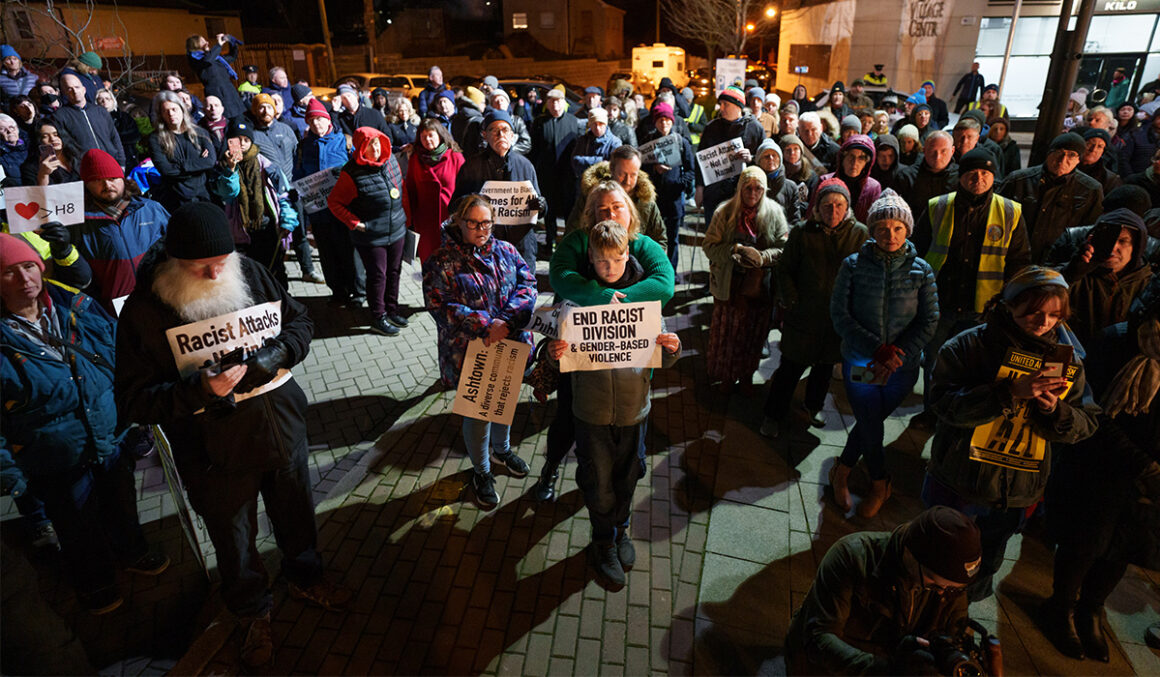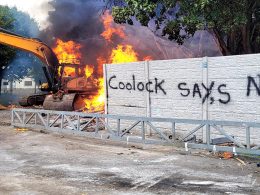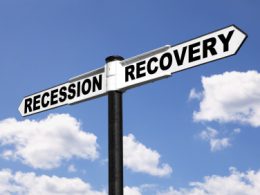In a shocking first, the early months of 2023 in the South were dominated by a series of protests against refugees in Dublin and multiple towns, orchestrated by fascist elements. Why now, what has created the basis for this reactionary development, and what does it represent? Who are the far right and what impact can they have? And crucially, what can be done to push them back? Here Kevin McLoughlin responds to these questions.
“’The crisis consists precisely in the fact that the old is dying and the new cannot be born; in this interregnum a great variety of morbid symptoms appear.” – Antonio Gramsci
Political reaction, which means opposition to political or social progress, has been a feature internationally now for many years, including with the reemergence of far-right and fascist forces. Ireland is now catching up, but reaction has been building up over time; nurtured in the wasteland created by decades of neo-liberal attacks on the economic and social position of working-class people.
Internationally, reaction is a consequence of the sell-out of the social democratic and labour parties in country after country over 30 years ago, when instead of fighting back against the neoliberal capitalist onslaught and providing an alternative to it, they went over completely to the side of capitalism – causing confusion, demoralisation and disorientation, and an overall knockback in workers’ organisation and consciousness, the effects of which still persist. In turn, a further price is being paid for the inability of new mass left parties in general to emerge in response to the Great Recession of 2007-09 and its aftermath.
Since then, the hatred of the political establishment who are culpable for the crisis has been reflected through other forces – with Trump coming to power in 2016 a highlight and trend setter, followed by Bolsanaro in Brazil in 2019. We’ve seen the further development of Le Pen’s National Rally (formerly National Front) in France, of the far-right Sweden Democrats and Brothers of Italy, led by Giorgia Meloni, coming to power in Sweden and Italy.
All the while Modi in India, Erdoğan in Turkey, Orban in Hungary, and many other despots around the world have maintained themselves in power, and incredibly there have been rightwing coups in Bolivia and Peru, and attempts at coups in the US and Brazil, and even a coup plot in Germany in 2022. This is the profoundly volatile world we live in.
Failures of the left, opportunities for the right
The overarching factor in the growth of reaction and far-right forces is the long-term economic decay of capitalism itself, and the multiple political and social consequences that flow from that.
Working-class people are naturally fearful and anxious as living standards decline and basics like decent housing, healthcare and education are beyond everyone, save for the wealthy. Wealth inequality, exploitation, environmental destruction and oppression are all increasing, adding a further edge to people’s anger. The alienation and the hatred of the establishment is palpable, hollowing out the support for the so-called liberal bourgeois democracy.
These are ripe conditions for socialist movements to grow, which was illustrated in Greece with the left party Syriza coming to power in 2015, but in particular by the mushrooming of mass support behind Bernie Sanders in the US and Jeremy Corbyn in Britain at a certain stage. In many countries, before the far right gained new positions and influence, there was first a desire and openness for a genuine left alternative.
Millions were looking to Sanders and Corbyn for an alternative. However, in these two cases, although it has to be said in every case so far, the chance was squandered and they proved incapable of giving a decisive socialist lead. Still, radicalisation and potential for the left is evident among young people, and young people are crucial.
But ‘nature abhors a vacuum’, so other forces are stepping in. Right-wing populism, consciously using demagogic attacks on the establishment or ‘elites’ (Trump demanding “drain the swamp”), has reemerged. While most capitalist classes in different countries do not want to embrace far-right or fascist rule, it does suit the system to begin to bring such forces into the mix in case they need them in the future.
Political instability and confusion
In general, capitalist society is becoming less democratic and more authoritarian. They are not able to rule as they did before. Even the so-called liberal French President Macron has had to repeatedly resort to executive decrees – bypassing the French parliament – to push through deeply unpopular legislation. Some rulers are therefore injecting divisive policies and ideas into society, essentially deploying the tactic of ‘divide and rule’. If they can divert attention away from their own responsibility for the state of the planet and the current economic and social conditions by pointing in other directions, including fabricating so-called “culture wars” and scapegoating refugees or migrant workers, they are satisfied.
This is the context in which far-right ideas and forces are on the rise and gaining an echo, including among sections of the working class. Those in desperate straits can be affected and misdirected by ideas that can seem to help them make sense of the injustice they experience, including even by reactionary or racist explanations to the problems they face.
Undoubtedly, the emergence of different social media platforms has given reaction and the far right tools, which they have expertly used, to make a real impact not only online. As Dr Ryan T. Williams has noted: “Far-right groups are some of the most successful adopters to this form of digital communication, targeting vulnerable people online, often young white men. Their strategies have become ever more sophisticated, radicalising people using vlogs, live streaming, and web forums.”
We see this too in the rise of conspiracy theories, which social media has helped to spread exponentially. As did events such as 9/11 in the US, which created disbelief and questioning on a different level than before. The subsequent invasions of Afghanistan and Iraq, which were shown to be wars based on lies, all contributed to global instability and political confusion, which helped the far right to seed their false narratives.
The wars that have developed since then, particularly in Syria and Ukraine, have produced a huge global refugee crisis. There are now 30 million refugees worldwide (among 100 million forcibly displaced people), all victims of a brutal capitalist system and its militarism, experiencing untold hardship. And the far right have exploited this crisis at every step.
Prejudice in Ireland
Ireland seemed to be the exception in having no serious or substantial far-right presence in politics, with some mistakenly thinking it related to the apparent liberal nature of Irish people. Conor Cruise O’Brien, a Labour Party TD in the 1970s, went so far as to state that, “The Irish character was peculiarly resistant to racism”. Significant immigration is a relatively recent phenomenon in Ireland, a country with a history dominated by mass emigration. The xenophobia that featured in other countries, while not completely absent, had not become a major political issue and some saw this as a positive portent for the future. The truth was more complex.
The racism that did and does exist in Ireland should not be underestimated. The delay in the arrival of more developed far-right organisations and more explicit racism didn’t relate to anything in the “Irish character”, but to a combination of factors. The period in which Ireland did begin to see a rise in immigration coincided with the Celtic Tiger boom, which served to mitigate some of the worst effects of neoliberalism, with employment and wages going up generally. The belated development and urbanisation of the country, including the increase of women in the workforce, also meant that movements for social progress coming from below came into their own over the last 20 years, and acted as a progressive pushback against reaction, such as the Marriage Equality victory in 2015 and the victory of abortion rights movement in 2018.
However, there have been other warning signs, in particular the passing of the racist Citizenship Referendum in 2004 by a vote of 79%, on a 60% turnout. Even in the middle of the resistance to austerity and the bailout, there were developments around right-populist and confused conspiracy groups like Direct Democracy Ireland, which were a peculiar mix of anti-EU, pro-landlord ideas. Furthermore, there was the 23.3% vote that Peter Casey achieved in the Presidential Election of 2018 having spewed scurrilous anti-Traveller racism in his campaign. In fact, anti-Traveller racism has long been a widespread problem in Irish society, one rarely acknowledged as a political issue until recently.
Rearing its ugly head
The pandemic and the lockdowns also proved transformative. The social and psychological impact of the pandemic on wide layers of the population is still not fully appreciated. A whole number of the currently existing far-right groups and individuals established themselves and their online presence in the early months of the pandemic, and it provided ideal conditions for them to grow their influence and their ability to mobilise – as seen in the demonstrations against lockdown restrictions, which numbered in the low thousands on a few occasions. They were in a much stronger position to operate when the restrictions ended, rather than wilt as many hoped they would.
Over the past year of Putin’s war in Ukraine, there has been a tenfold increase in the number of refugees coming to Ireland. To this government’s shame, refugees have often experienced poor quality accommodation, and some have shockingly been forced to sleep rough. Coinciding as it did with the already existing housing crisis, this gifted the far right an opportunity to organise protests in many areas, often using the idea that the government will act for refugees but do nothing for Irish people suffering from the housing crisis. And this idea has some power because it has some truth to it. Not because the government favours refugees (who it treats abysmally in Direct Provision centres), but because it had no choice. Under pressure from the EU, it was forced to go further in finding ways to accommodate refugees, with an urgency it never displayed for Irish or migrant homeless people in the last ten years.
As well as twisting the housing crisis to blame refugees, the far right operated straight out of the fascist playbook when calling for protests against ‘unvetted males’ and whipping up a disgusting hysteria around the alleged threat of assault to women and children by refugees.
Emboldened by successes
An accurate assessment of where things stand is important in determining how best to combat these groups and their potential influence. There are now a plethora of individuals and groups trying to make a name for themselves including, the Irish Freedom Party, the National Party, Ireland First, Yellow Vest Ireland, Rise Up Ireland, Seed of Ireland, Irish Council for Human Rights, and Anti-Corruption Ireland. There is undoubtedly cooperation among these groups and individuals, and connections with far-right and fascist groups in other countries, notably Nigel Farage and Tommy Robinson. The methods and tactics used by the far right in the US and Britain are adapted to fit here.
They have demonstrated an ability to use social media platforms to great effect. One informed observer estimates they have up to 100 capable operators consistently working on social media. This ability to impact was demonstrated in late December 2020 when within minutes of the Garda shooting dead George Nkencho, a young Black man in Blanchardstown, they organised through Telegram and other platforms to successfully flood social media with a slew of disgusting racist lies about George.
In late 2022 and early 2023, beyond the still relatively small numbers of the fascist hardcore, there have been numerous protests with several hundred on them, meaning that overall a few thousand have probably been involved in anti-refugee protests in recent months. A greater number of women have attended the protests compared to previous far-right actions. Some of those attending do so out of misdirected anger at the housing crisis or fears about gender violence. Others attend because they are more generally disaffected, demoralised and frustrated, and want to lash out.
Undoubtedly, the racist attitudes which do exist in society are also contributing to the attendance at these protests. This has added to the atmosphere of menace on display. No doubt the far-right and fascist groups are likely to recruit new members from these layers, and given that all the broad factors that helped this situation to emerge in the first place will continue, it is likely that they can also grow the periphery around them.
A demonstrable impact
The key questions are how much broader is their influence, and how much broader could it become? They have already had an impact in society, making the issue of refugees a bigger political issue than it would have been, although the government’s disastrous handling of the influx was always going to make it an issue. More clearly they have had an impact on official politics, with the position of the government parties shifting further to the right on the issue. An article in The Irish Times recently put it:
“Virally spreading claims of sexual assaults by migrants on social media, demonising journalists and picketing accommodation centres are all tried and tested. The description of people as “unvetted” uses a word borrowed from the long-running immigration rows in the US. The sequence of events that has played out across Europe since 2015 has been as follows. The logistical challenge of accommodating an influx of new people is exploited by those who are opposed to immigration already… Political opportunists take up the issue, using shock tactics to court media attention and amplify their profile and message. To compete with these upstarts and avoid being painted as “soft” on migration, established political parties echo and often ultimately adopt their positions, shifting the centre-ground towards the anti-immigrant right.”
We’ve heard such comments from establishment politicians, including Leo Varadkar who said the government’s policy on asylum seekers should be “firm, fair and hard”, and the government has adopted a harsher approach to refugees, boasting about deporting 130 people in January alone.
It would be a mistake to underestimate the potential of the developing fascist hardcore to broaden its influence further in the future. And of course, it is refugees, migrants and people of colour who will feel the brunt of this racist rhetoric, including in threats and physical attacks, as well as constant fear.
Taking them on
There must be a robust response to the far-right threat. We are not just dealing with unpleasant, nasty people, we are dealing with an ideology and a movement that has a base and a history to it. Fascism is an extreme form of capitalist rule, the last resort when democratic rights can no longer be afforded because they impede the ruling class and their pursuit of profit at the expense of society. Fascist movements which develop into major forces in society are invariably funded by big business interests. Historically, the goal of fascists was to undermine and crush democratic rights and especially working-class organisations.
This was done by propaganda and brute force. Fascism mobilised the ruined middle classes and the most disenfranchised sections of the unemployed working class, and scapegoated certain groups as being responsible for the problems in society. In that way, they divide and weaken the working class, pick off their enemies and grind their way to dictatorship.
The main lesson from the history of fascism is to prevent fascists from getting a foothold. In general, socialists adopt the position of ‘no platform for fascists’. That is, they should not be allowed to avail of the basic democratic rights in society to spread their dangerous poison. For example, if fascists were organising a demonstration, a public meeting or opening an office, there should be a campaign to stop them from going ahead, because if they succeed with any of these things it would embolden them and their ideas. Any success for them invariably leads to a growth in racism, misogyny and LGBTQ-phobia, and violent attacks.
Fascists should not be allowed to avail of the democratic rights won by working-class people so they can in turn crush those same rights for us all. The Socialist Party, others on the left and anti-racist activists have on numerous occasions in the past successfully forced the cancellation of far-right events, or forced fascists off the streets by the sheer weight of the numbers mobilised to resist them.
However, the situation is now more complex than before. When fascists have the ear of a section of people, instead of weakening them, shutting them down can create sympathy for them among some who don’t really understand the danger fascists pose, and can potentially increase their support. Also, social media facilitates everyone to publish and propagate their ideas, and the companies who run them benefit from the controversial content posted by the far right. In these circumstances, it is extremely difficult for anti-fascists to implement a full ‘no platform’ position.
Tactics and approaches
Generally, counter-protests are good and should be organised, but the whole point of a counter-protest is to significantly outnumber the fascists and by weight of numbers pressurise them from the streets, which is a blow and demoralises them. If you can’t outnumber them, then a counter-protest can actually be counterproductive. What results is a standoff, or worse, they outnumber us and it backfires. If you call a counter-protest, you have the responsibility to properly organise a mobilisation broader than just those on the left. It means mobilising working-class and young people from workplaces, communities, schools and colleges.
What follows from this is that a serious approach to pushing back the far right and fascists means spreading awareness and information, and engaging in discussions in the aforementioned arenas about the threat posed and what needs to be done. Some people who have a liberal approach may think it is enough to make moral arguments about racism being unjust. However, it would be a mistake not to directly take up the arguments that the far right use to try to worm their way into the population. If at all possible, it is best to chip away at the broader layers that come around the far right through their manipulation and abuse of legitimate issues.
Any campaign against the far right has to take up the housing issue, and the best way to show that the crisis is not the fault of refugees is to show who is responsible, namely the government, the landlords and private developers. The most convincing and effective arguments against the anti-migrant scapegoating are the ones that show that capitalist policies are at the heart of the problems we face; that there are more than enough wealth and resources for everyone to have what they need, and that the battle isn’t among working-class people, but between all of us and the super-rich capitalist class. Obviously, this means such campaigns must be independent of, and in clear opposition to, the government parties.
As part of this we should show the far right’s true colours, how they favour landlords over tenants, bosses over workers, in the same way as they favour militarism over the victims of war. We need solidarity among working-class people here, and among all working-class people internationally.
Forces of the future against forces of the past
It isn’t just about making the correct arguments, it is necessary where possible to initiate active mass campaigns – on housing and other issues – to provide concrete ways people can struggle on the issues. The Socialist Party has recently initiated community-based housing campaigns in Cork and Dublin West and are seeking to see if housing could successfully be made an issue for trade unions to organise on.
Generally, but certainly in the current environment, trade unions have a responsibility to combat racism in the workplaces, so many of which are now multiethnic. Whether it be racism from management, the public, or from other workers, it needs to be stamped out. Moreover, the unions, with over 500,000 members in the South represent the most powerful force that can be, and must be, mobilised against the far right’s growing presence in society.
Some far-right organisations are attempting to build a base in particular geographical areas, where they poster, leaflet and knock on doors. It would perhaps not be advisable at this point to physically confront them on these activities, but it is completely appropriate to establish anti-racist networks of people in the communities, which respond to what the far right are doing. For example, removing racist posters, stickers, and graffiti, leafleting the areas they covered and even door-knocking to engage people and make them aware of what these forces really stand for.
In that way, broad networks could play a role in firming up intolerance in communities against the far right which could undermine their ability to be active. Such networks can also discuss and organise security and stewarding at events organised by groups or communities that could be targeted for disruption by the far right.
As mentioned earlier, young people have a crucial role to play and will tend to take the lead in challenging racism, but also crucially the transphobia and misogyny of the far right, which is deeply embedded in its DNA. In the past, youthful left-wing organisations, such as Youth Against Racism in Europe (YRE), played a role in bringing young people together and organising against the far right. Young people led Irish society forward on women’s and LGBTQ rights, and they can do the same on racism. Socialists will be at the fore in this struggle.
The emergence of the far-right in Ireland has been shocking, but it is forcing young people to consider getting active. Fighting the far-right, who are in essence symptomatic of capitalism in decay, necessarily raises the need for an alternative to capitalism, and there is a real prospect that many will draw the necessary socialist conclusions.












